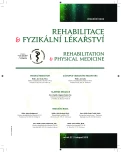Dysphagia after Cerebrovascular Accident
Authors:
P. Konečný 1,2,3,6,7; M. Elfmark 2,5; S. Horák 2; T. Kadlčík 4; P. Dobšák 3,6; R. Mikulík
Authors‘ workplace:
Rehabilitace NMB Brno a CLR Prostějov
primář MUDr. P. Konečný, Ph. D.
1; Fyzioterapie FZV UP Olomouc
přednosta doc. MUDr. A. Krobot, Ph. D.
2; KFRL LF MU Brno
prof. MUDr. P. Dobšák, CSc.
3; RTG DN FN Brno
doc. MUDr. J. Skotáková, CSc.
4; KPVK FTK UP Olomouc
přednosta prof. RNDr. M. Janura, CSc.
5; ICRC FNUSA Brno
ředitel G. B. Stokin, M. D., MSc., Ph. D.
6; Neurologická klinika LF UP Olomouc
přednosta prof. MUDr. P. Kaňovský, CSc.
7
Published in:
Rehabil. fyz. Lék., 22, 2015, No. 4, pp. 181-184.
Category:
Original Papers
Overview
Dysphagia occurs very frequently within the framework of bulbar or pseudobulbar syndrome in patients after cerebrovascular accident. For the diagnosis and evaluation of the gravity of the affection the authors use videofluorographic examination of the swallowing act. Orofacial rehabilitation is recommended in the treatment of swallowing disorders. The results of orofacial rehabilitation using videofluorographic examination are described in a prospective pilot study in nine patients suffering from swallowing disorders after CVA.
Keywords:
cerebrovascular accident, dysphagia, orofacial rehabilitation
Sources
1. BUNOVÁ, B.: Špecializované vyšetrenia hltacieho aktu. In: TEDLA, M.: Poruchy polykání. Havlíčkův Brod, Tobiáš, 2009, s. 58 - 64.
2. BULOW, M. et al.: Neuromuscular electrical stimulation (NMES) in stroke patients with oral and pharyngeal dysphagia. Dysphagia, 23, 2008, s. 302-309.
3. CARRY, M. A., CARNABYMANN, G. D., GROHER, M. E.: Initial psychometric assessment of a functional oral intake scale for dysphagia in stroke patients. Arch. Phys. Med. Rehabil., 86, 2005, s. 1516-1560.
4. CASTILLO MORALES, R.: Die Orofaziale Regulationstherapie. Munchen, Berlin, Heidelberg, Pflaum, 1998.
5. ČERNÝ, M., KOTULEK, M., CHROBOK, V.: FEES-flexibilní endoskopické vyšetření polykání. Endoskopie, roč. 20, 2011, č. 2, s. 70-75.
6. DANIELS, S. K. et al.: Clinical assesment of swallowing and prediction of dysphagia severity. J. Speech Language Pathol., 1997, 6, s. 17-24.
7. GANGALE, D., C.: Rehabilitace orofaciální oblasti. Praha, Grada Publishing, 2004.
8. HÄGG, M., LARSSON, B.: Effects of motor and sensory stimulation in stroke patiens with long-lasting dysphagia. Dysphagia, 19, 2004, 4, s. 219-230.
9. HERZIG, R., VLACHOVÁ, I.: Cévní onemocnění mozku a míchy. In: Kaňovský P., Herzig R. et al.: Speciální neurologie. Olomouc, Univerzita Palackého, 2007, s. 7-36.
10. KANIOVÁ, M. et al.: Poruchy polykání u Parkinsonovy nemoci. Neurol. praxi., roč. 15, 2014, č. 6, s. 329-332.
11. KITTEL, A.: Myofunkční terapie. Praha, Grada Publishing, 1999.
12. KONEČNÝ, P., ELFMARK, M., URBÁNEK, K.: Facial paresis after stroke and its impact on patients´ facial movement and mental status. Journal of Rehabilitation Medicine, 43, 2011, s. 73-75.
13. LOGEMANN, J. A.: Evaluation and treatment of swallowing disorders. 2nd ed. Texas: PRO ED, 1998, s. 406.
14. MANN, G., HANKEY, G. J., CAMERON, D.: Swallowing disorders following acute stroke. Cerebrovasc Dis., 10, 2000, s. 380-386.
15. MARTINO, R. et al.: Dysphagia after stroke. Stroke, 36, 2005, s. 2756-2763.
16. O´DONOGHUTE, S., BAGNALL, A.: Videofluoroscopic evaluation in the assessment of swallowing disorders. Folia Phoniatr Logop., 51, 1999, 5.s. 158-171.
17. PERMSIRIVANICH, W. et al.: Comparing the effects of rehabilitation swallowing therapy vs. neuromuscular electrical stimulation therapy among stroke patients with persistent pharyngeal dysphagia: a randomized controlled study. J. Med. Assoc. Thai., 92, 2009, 2, s. 259-265.
18. POWER, M. L. et al.: Evaluating oral stimulation as a treatment for dysphagia after stroke. Dysphagia, 21, 2006, s. 1-7.
19. SINGH, S., HAMDY, S.: Dysphagia in stroke patients. Postgrad. Med. J., 86, 2006, s. 383-391.
20. SHAKER R. et al.: Pressure-flow dynamics of the oral phase of swallowing. Dysphagia,1988, 3, s. 79–84.
21. SMITHARD, D. G. et al.: Complications and outcome after acute stroke. Stroke, 27, 1996, s. 1200-1204.
22. SOLNÁ, G., LASOTOVÁ, N., LEBEDOVÁ, Z. et al.: Návrh jednotného postupu v péči o pacienty s dysfagií na iktových jednotkách v ČR. Dostupné on-line: http://nemocnicevitkovice.agel.cz/oddeleni/neurologicke-oddeleni/ke-stazeni/pece-o-pac-dysfagie.pdf.
23. STRNADOVÁ, V.: Správná klinická praxe (GCP) pro lékaře. Interv. Akut. Kardiol., roč. 9, 2010, č. 6, s. 329-332.
24. TEDLA, M. et al.: Poruchy polykání. Halvíčkův Brod, Tobiáš, 2009, s. 298.
Labels
Physiotherapist, university degree Rehabilitation Sports medicineArticle was published in
Rehabilitation & Physical Medicine

2015 Issue 4
- Hope Awakens with Early Diagnosis of Parkinson's Disease Based on Skin Odor
- Deep stimulation of the globus pallidus improved clinical symptoms in a patient with refractory parkinsonism and genetic mutation
Most read in this issue
- Plastic Surgery of the Anterior Cruciate Ligament by the Press-fit Method of Femoral Fixation: Specifics in Rehabilitation Treatment
- The Application of Eccentric Movement in the Treatment of Tendinopathies
- Fundamentals of Rehabilitation Techniques in Patients with Dysphagia after Resection of Tumors in Oropharyngeal Region
- Dysphagia after Cerebrovascular Accident
